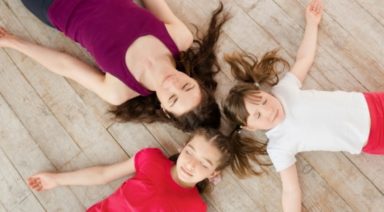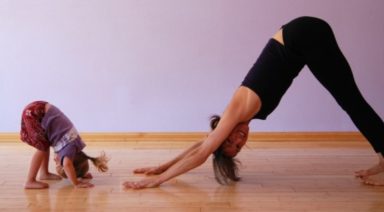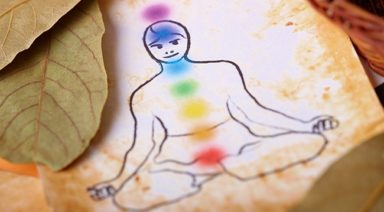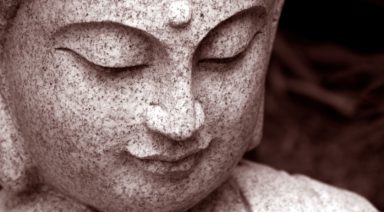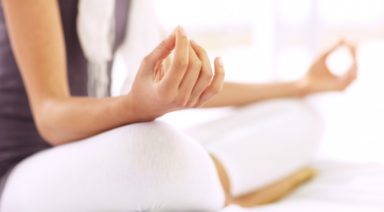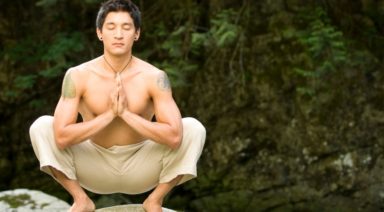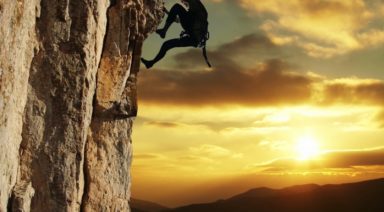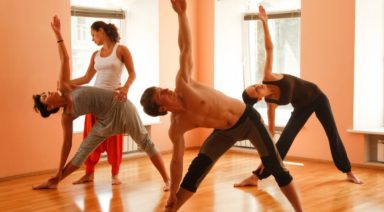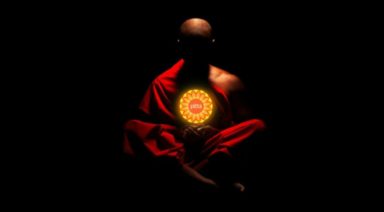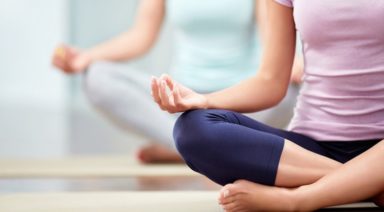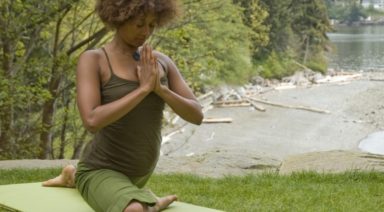Childbirth and the Mind Body Connection

It is not surprising that yoga and childbirth have a lot in common…gentlemen stay with me! Max Strom, yoga teacher and author of “A Life Worth Breathing,” states that, “the only people in this country, on a wide scale, that are taught how to breathe are woman about to give birth,” (and yogis of course). Although sensations during birth are much more intense than sensations in a yoga posture, both practices help to develop tools to establish a sense of calm amongst internal chaos. Due to the fact that I have an interest in both of these astounding practices, I stuck my nose in “Guide to Childbirth,” written by one of North America’s top midwives, Ina May Gaskin. In her book she not only shares her client’s birth stories, but also shares her personal birthing tips and tricks. One observation that Ina has made over the years is how powerful the mind/body connection is. This relationship between the body and mind is what I’d like to focus on, because miraculously it is a relationship that is strengthened through yoga as well.
Most of us brought up in Western cultures are taught that thoughts and feelings don’t matter when it comes to the functioning of your body. Ina states, “When something goes wrong with the body, our culture teaches that pharmaceutical medicines or surgery will be necessary.” In the early stages of her career she quickly learned that we cannot afford to overlook the mind/body connection in labor and delivery. Here is an example of how strong the bond can be.
In many cases, a woman’s cervix will dilate at a steady rate to about seven centimeters, but then can became locked there for several hours. When this occurs, Ina begins an open dialogue with the soon to be mother to try and get to the bottom of her physical hold up. She discovered that in all cases, the delay was due to an emotional blockage that needed to be released before the cervix could relax.
One woman was riddled with fear of dying in childbirth. As soon as she confided in Ina, her baby was born within two hours. Ina reflects, “I was quite impressed to know that an unspoken terrible thought could so powerfully alter a woman’s body’s ability to perform a normal physiological function.”
Talk about reestablishing trust in your intuition and feelings: Ina said that if someone walked into the room who wasn’t intimate with the laboring mother, labor would often come to a halt. If that person then left the room, only then would the birthing process return to its natural pace and intensity.
In another case, the power of mantra (a sound, word, or group of words that is capable of “creating transformation”) was used to progress the physical body in labor. This woman experienced her cervix opening just after her husband whispered in her ear, “You’re marvelous.” The couple continued to use positive affirmation to ease their baby into the world free of medication, mechanical intervention, or surgery.
Mantra, as well as meditation, pranayama and asana, is an important part of yoga that helps enhance mind/body coordination. “These techniques help to awaken poise, grace, strength, and the development of centered awareness, even in the midst of chaos and turmoil, ” shares physician and spiritual guide, Deepak Chopra. It’s quite impressive to watch the muscles, nervous system, the breath, and heartbeat become affected by what is happening in the mind. For example, if you hit meditation after a whirlwind of a day, you can calm yourself quite quickly and efficiently by focusing the mind on a relaxing image or word.
Lately, I’ve been experimenting with mantra, to try to decipher if it makes an impact on my practice or not. What pose did I choose to be my guinea pig? Obviously handstand, as there is so much mental and emotional turmoil around this popular little bugger! Upon hopping into it, I silently recited one word in my head to see if my body would respond. Overzealous mantras, caused me to flip past centre, cartwheeling to one side. A softer word, or even no word at all, seemed to have kept my hips far behind my shoulders; I was still far from making the cover of Yoga Journal! Finally, I discovered that it was a mantra between the two extremes that helped click me into that sweet spot. I hopped to the word, “ strong” or “ stick it” and literally hung out with my handstand for a few breaths. To help nail handstand, sometimes I’ll trick my body with my imagination. Call me crazy, but yesterday I put a pretend pit of snakes behind me and I didn’t fall out of it once!
Another way to deepen your understanding of the body/mind connection is to periodically check in with your overall experience in a pose. For example, if I observe my body struggling I’ll go upstairs and scan over my thoughts. Almost 90% of the time I’ll discover that my mind is either dark, negative, distracted or unsupportive. If the body is being challenged by an advance posture, eventually you can ease your experience by softening the edges around reactive thoughts. Change your habitual thinking patterns to therefore change the overall bhava, or mood, of the pose.
Chopra affirms that, “the activity in your mind is communicated to every cell in your body. When your mind is turbulent your messenger molecules communicate turbulence to your cells, tissues and organs. If you can quiet your mind, you can send messages of peace and harmony to every cell in your body.”
Your body is listening, so never forget that thoughts become things!
Animal Yoga Poses for Kids
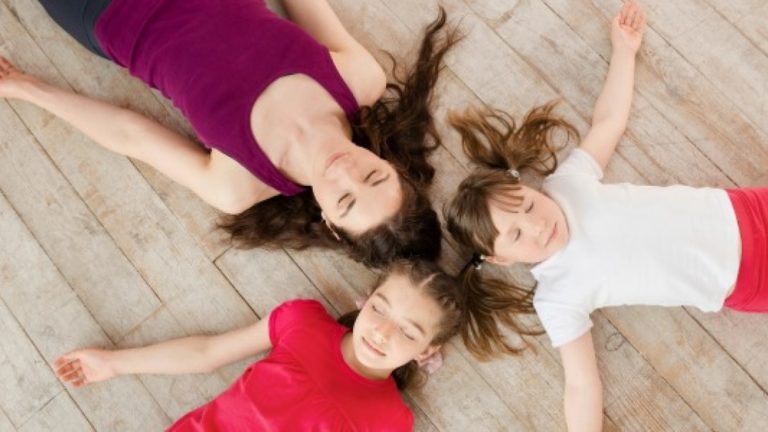
In the midst of discussing her chicken nuggets (she eats only the dinosaur shaped ones in the green box), she rolled back onto the padded window seat, bent her four-year-old knees into her little armpits and grabbed her feet. Happy Babies Pose. Gigi kept right on talking, sticking her head between her feet to look up at me with big brown in her smiling face. I marveled at my niece’s intuition and ability to move into yoga poses. At any time. And although the practice of yoga is very much a part of my life, her mom, my sister Robin, doesn’t practice yoga at all. In fact, when I asked her, Robin said Gigi had not been exposed to yoga. And yet, at four years old, she knew exactly how to move her body into many of the traditional poses.
Yoga postures, referred to as asana in Sanskrit, the language of Yoga, emulate animal shapes, elements in nature, and aspects of our surrounding world. Kids naturally create many these types of shapes with their bodies, in playful and expressive ways. My first thought was, “oh no! You shouldn’t compress the abdomen like in Happy Baby pose, mid-meal. Nor is it ideal to combine yoga and eating.” But my second thought, “Of course she’d come into Happy Baby pose, as she’s happiest when she’s eating dinosaur nuggets, the kind from the green package,” reminded me of the power of connection through yoga. Happy feeling = Happy Baby Pose.
With tools to listen and deepen our intuition, the practice of yoga connects us with our internal landscapes: breath, sensation, body awareness, and mental & physical balance. Simultaneously, yoga poses join us with our external landscapes, with the natural world and with one another. For example, when kids are encouraged to take the yoga pose of Frog, squatting with feet and knees wide, they can’t help but want to make some ‘ribbit’ sounds and hop around!
In our technology-saturated world, connection with nature, each other, and ourselves becomes an even more vital practice.
There are numerous studies on the benefits of yoga poses for kids. One such study, conducted by Kristie Patten Koenig, an assistant professor of occupational therapy at New York University, focused on elementary school kids and yoga. She and her team of researchers and teachers had the kids follow a specific routine each morning, five days a week, for 17 minutes. The routine: mats out, breathe deep, assume yoga poses, tense and relax muscles, and, finally, sing. Koenig says that yoga was effective because it seems to play to the strengths of kids (particularly those with autism), while also reducing stress. The researchers surveyed teachers at a school in the Bronx who said a daily yoga program reduced the kids’ aggressive behavior, social withdrawal and hyperactivity. “We know that anxiety fuels a lot of negative behavior, so the yoga program gives them a strategy to cope with it,” Koenig reported. “And if it’s done every morning, it becomes an integral part of the day that sets the status of the classroom and allows the kids to become calm, focused and ready to learn.”
In addition to aiding connection, yoga poses and the practices of yoga (mindfulness and breath along with movement) cultivate kids’ abilities to focus and concentrate. Yoga is increasingly being used in classrooms across the U.S. to improve the behavior and performance of kids. Additional research suggests that yoga practices help kids concentrate and focus, and improves their strength, motor coordination and social skills. Teachers report that yoga poses for kids aid in decreasing problematic behaviors.
Eight Yoga Poses for Kids
Whether you’re a teacher, parent, relative, or babysitter, kids yoga poses can be utilized in either formal teaching practice or informal play. Here are eight yoga poses for kids that can be used to enhance connection with the animal kingdom, themselves and each other. Kids can learn to welcome the sun in the morning and say goodnight to the sun in the evening, in their own yogic way.
As you’re directing kids into these shapes, allow space for their creativity and intuition to be a part of the practice. To create a deeper sense of unity and interaction, yoga mats can be placed in a circle. Use the time setting up the poses and between poses to provide information about the animal(s), their behaviors, and what we have in common with them and with each other. Allow space for both learning and play, while encouraging interaction with one other when appropriate and also the ability for each kid to connect with their own breath and sensations.

Lion Pose
- Come to hands and knees on the mat to create a table position
- Face soft to start
- Draw hips back towards heels in a pre-pounce
- Pounce forward on the mat, staying on hands and knees
- “ROAR!” sticking tongue out and looking up towards ceiling
Lion Pose is useful to teach kids to identify and manage their emotions. By linking sound and movement through the yogic practice, kids yoga poses such as Lion, create the teaching of healthy anger outlets and helps to limit emotional outbursts.

Down Dog
- Come to hands and knees on the mat in a table position
- Move hands forward one handprint
- Curl toes under
- Lift hips to the sky
- Breath work: Begin to pant with tongue hanging out, then close mouth keep the same ‘panting’ out the nose (Breath of Fire)
Down Dog Pose can be used to connect with others. Kids can take their Down Dog’s for a ‘walk’ moving off their mats and around the room, greeting other ‘Dogs’. Another option for Dog Pose in a group is to form a line of Down Dogs making a tunnel like opening beneath their bodies. One at a time, have a kid come onto their belly for Caterpillar and inch worm their way beneath the lifted Dog Poses.
Puppy Dog
- Come to hands and knees on the mat in a table position
- Walk hands forward until chest comes to the mat
- Keep arms outstretched
- Keep knees on the mat, lift ‘tail’ high
- Can make funny puppy faces, and ‘wag tails’
Puppy Dog Pose is a nice set up and/or release from Down Dog Pose. It can be used to initiate the strength to create Down Dog Pose as well as provide a softening release from it. Similarly, it can be helpful in revving up energy for Down Dog Pose (especially in a group line of Down Dogs) and bringing that same energy back down.
Caterpillar Pose
- Lay belly down on the mat
- Begin to wiggle through hips
- Either arms extended overhead or alongside hips
- Practice inching forward without using hands and feet
Cocoon Pose
- Lay either belly down or on back on the mat
- If using progression from Caterpillar to Butterfly; easier to be belly down
- Be still; unmoving
- Deep breaths
- Breath work: begin to breathe in at toes, up through legs, belly, chest, arms, throat, face and up through top of the head. Breathe out starting at top of the head, all the way back down, completing breath out from the toes

Butterfly Pose
- Lay belly down on the yoga mat
- Extend arms out to the sides
- Lift straight arms to sides of the room
- Lift straight legs to back of the room
- Can flutter arms like butterfly wings
Caterpillar, Butterfly and Cocoon/Corpse Poses linked together provide a wonderful opportunity to teach about the scientific transformation that occurs, as a caterpillar becomes an entirely different shape in the form of a butterfly. Depending on the ages of kids, you could incorporate information about how a caterpillar essentially turns to liquid in its cocoon, and then emerges as a completely different shape in butterfly.
Butterfly is another yogic shape that can be used as a pose of connection. Kids can make a circle with their mats, belly down, just less than arms distance apart. When they lift their arms, bellies connected to their mats, they can link arms with one another and fly together! Another option is to have kids emerge from Cocoon Pose onto their feet and explore ‘flying’ as butterflies to interact with one another around the room.

Childs Pose
- Kneel on mat with knees wide
- Big toes touch
- Lay belly towards mat
- Arms extended overhead
- Rest forehead on mat

Frog Pose
- Place feet wide on the mat
- Lower hips into a squat position
- Hands come to heart center
- Make ‘ribbit’ sounds
- Option to hop!
Frog Pose is another asana that can be used for interactive play. Invite kids in Frog pose to hop around and engage with one another for up to a minute. Then hop back to their mats and take Childs pose: wide knees lower on to the mat, hips back towards heels, forehead to the mat. These types of yoga poses for kids are a good practice in learning to extend energy through engagement outwards, followed immediately by pulling energy back in.
How would the world be different if our children are taught and encouraged to listen to their intuition?
If our children are supported to express their thoughts, ideas and emotions through yoga poses in a form of healthy play and self-expression? What if, rather than an alternative form of exercise that only occurred in studios, yoga became a way of communicating with ourselves, each other and the world around us?



